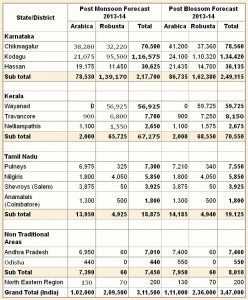BANGALORE – The Post Monsoon crop forecast for the year 2013-14 is placed at 311,500 MT, which shown a reduction of 35,500 MT (-10.23%) over the post blossom estimate of 2013-14 of 347,000 MT.
Of the total estimate, the break up for Arabica and Robusta is 102,000 MT and 209,500 MT respectively.
Arabica production estimate has shown a decline of 9,000 MT (-8.11%) while robusta declined by 26,500 MT (-11.23%) over the post blossom estimate of 2013-14.
By the states, the decline is mainly seen in Karnataka to the tune of 31,415 MT (-12.61%) while Kerala has shown a marginal decrease of 3,275 MT (-4.64%) compared to the post blossom estimate (click the image to enlarge the table).
In Karnataka, Kodagu district experienced a decline of 17,845 MT (-13.28%) both in Arabica (3,025 MT or -12.55%) and robusta (14,820 MT or -13.43%) followed by Chikmagalur (8,060 MT or -10.26%) and Hassan (5,510 MT or -15.25%) over the post blossom forecast.
The reasons for reduction in production estimates is attributed that during the current cropping season, coffee areas have witnessed a long period of drought after receiving blossom showers, followed by an extremely harsh monsoon.
The monsoon which started on time continued unabated very heavily with some areas witnessing continuous rainfall for more than 60 days.
The continuous showers led to soil saturation and wet feet conditions resulting in defoliation, berry drop and incidences of stalk rot and black rot. Uprooting of shade trees too has been reported.
It may be noted that before the onset of monsoon, there was a heavy proliferation of
White Stem Borer because of the long period of drought in the months of April/May, but subsequent monsoon rains helped in preventing further spread of this pest.
Taking into account of all these factors, the post monsoon crop estimate for Karnataka is placed at 217,700 MT with a break up of 78,530 MT of arabica and 139,170 MT of robusta.
In Kerala, the adverse effect on crop due to premature berry drop, stalk rot and black rot diseases due to continuous rains was less prominent overall, but resulted in marginal decline in Waynad (2800 MT or -4.69%) and Travancore (450 MT or -5.52%) regions over the post blossom estimate.
Therefore the post monsoon forecast is placed at 67,275 MT (Arabica 2000 MT and Robusta 65,275 MT) against the post blossom estimate of 70,550 MT.
In Tamil Nadu post monsoon forecast is placed at 18,875 MT against 19,125 MT of post blossom estimate which is a marginal decrease in production of 250 MT mainly observed in Adalur and Bodinayakanur of Pulneys region due to deficit in rainfall.
In Non-Traditional areas of Andhra Pradesh and Orissa and North Eastern Region, the post monsoon forecast is placed at 7,650 MT against post blossom estimate of 8,010 MT.








 CAPS: the new proprietary system using capsules made of 85% recycled aluminium
CAPS: the new proprietary system using capsules made of 85% recycled aluminium









